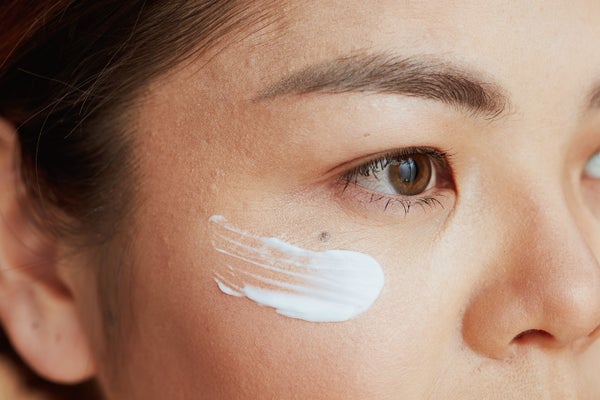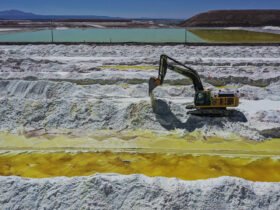September 11, 2024
4 min read
How Retinol Cosmetics Change Skin at a Chemical Level
Experts explain the differences between popular retinol products and the way they trigger molecular changes deep in the skin

CentralITAlliance/Getty Images
With such a vast and often bewildering assortment of skin-care products on the market, it’s hard to know if their arcane arrays of compounds or other chemicals really do what their label claims. But from a scientific perspective, one ingredient stands out among the rest: retinol. Decades of research show it significantly benefits skin, especially in treating acne and signs of aging. What exactly is it that makes retinol so effective?
Retinol is a type of retinoid, a blanket term for a family of compounds derived from vitamin A. They first came into prominence in the 1970s, when retinoic acid—the active form of vitamin A, which is also known as the topical prescription medication tretinoin—was used to treat acne. The family includes adapalene, retinaldehyde, retinyl esters and of course retinol itself, all of which are available over the counter. Retinoids are often popularly referred to as “retinols,” but there are some important differences among them.
What sets each apart is its potency, which is based on how many steps it takes to convert to retinoic acid. This compound binds to receptors in the nuclei of skin cells, immediately triggering a series of cellular changes that promote skin health. Retinoic acid stimulates the rapid turnover of cells, which can help a user shed dead skin—but it can sometimes lead to unwanted side effects such as dryness and peeling. Most over-the-counter retinoid products contain what are known as precursor molecules, which need to be converted to retinoic acid to have biological effects. Retinyl esters, the least potent form of retinoids, need to go through three enzymatic steps before they become active, making them a gentler option—but they are not as well studied as the other compounds in the family, explains Patricia K. Farris, a clinical associate professor of dermatology at Tulane University School of Medicine. Retinol requires one less step: it converts to retinaldehyde and then to retinoic acid.
On supporting science journalism
If you’re enjoying this article, consider supporting our award-winning journalism by subscribing. By purchasing a subscription you are helping to ensure the future of impactful stories about the discoveries and ideas shaping our world today.
Most dermatologists estimate that retinol is roughly 10 times less potent than tretinoin, meaning that when retinol undergoes the conversion process, only about 10 percent of it becomes retinoic acid. (In the majority of tretinoin products, the concentration of that active ingredient is typically 0.025 to 0.1 percent.) That’s why over-the-counter products contain higher concentrations of retinol, says Farris. “We have to ‘flood’ the skin” with the product, she explains, because only a fraction of retinol is enzymatically converted.
Once it’s applied, retinoic acid gets to work on the signs of aging skin. As people grow older, sun exposure and pollutants, combined with lifestyle factors such as stress and lack of sleep, lead to the production of free radicals, says Farris. Free radicals are highly reactive molecules that can damage skin cells. Skin experiences oxidative stress when it cannot neutralize these free radicals with antioxidants. This stress increases the production of enzymes called matrix metalloproteinases (MMPs), which break down collagen and the other kinds of “cement” that hold skin cells together, says Zakia Rahman, a clinical professor of dermatology at the Stanford University School of Medicine.
When retinoic acid binds to its receptors, it increases collagen production and reduces MMP activity. Retinoic acid also ramps up the production of elastin, a protein that gives skin its springiness. It further stimulates production of glycosaminoglycans (such as hyaluronic acid) that help to keep the skin hydrated and plump. Retinoids additionally thicken the epidermis, the outermost layer of the skin, which makes skin look smoother and wrinkles appear less prominent. Retinoic acid also increases cell turnover to help shed old, dead skin cells more quickly, reducing dark spots and pigmentation and revealing new skin. And the compound acts on oil-producing skin cells to reduce sebum production; this is useful because sebum and dead skin cells can clog pores, creating a moist environment that helps bacteria to thrive. As these bacteria gobble up sebum, they trigger an inflammatory response in the skin, which leads to acne. “All of these things [retinoids do] make the skin not only look better but actually function better,” Rahman says.
When it comes to these medications, however, stronger doesn’t necessarily mean more effective. One study compared the three concentrations of tretinoin that are typically prescribed, with retinol products that have a corresponding strength. The researchers applied each to a side of participants’ face and found no significant difference among the results: both the tretinoin and retinol treatments helped with sun damage, fine lines, wrinkles, pigmentation and pore size. Retinols are marketed as “cosmeceuticals,” over-the-counter beauty products that are usually thought of as having only aesthetic effects. But that “doesn’t mean they don’t have a biological effect,” Rahman says, although “it does take a little bit longer for that [effect] to happen” with these products.
Retinoids can also cause side effects. Oral isotretinoin, a potent derivative of vitamin A that is used for severe acne, is known to cause birth defects if it is taken during pregnancy. Topical retinoids are generally deemed to be safer, but dermatologists still don’t recommend them to pregnant people. With prescription retinoids, a common complaint is skin “purging,” or retinoid dermatitis, which is characterized by redness, peeling and irritation. That’s why over-the-counter retinoids can be a better place to start, even though some people might still experience side effects from them. Retinoic dermatitis is usually a temporary side effect—but if it shows up, it’s important to consult with a dermatologist on whether to stop using the product. When you find a product that suits your skin, Farris and Rahman say most retinoids will start to benefit the skin in about a month, but the results may take longer to become visible. And the longer you use the product, the better the results and more tolerable they become, Rahman says. She advises against mixing too many products containing active ingredients in a skin-care routine. “You can break down the skin barrier,” she says, which protects the skin from irritants and locks in moisture.













Leave a Reply